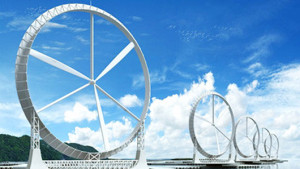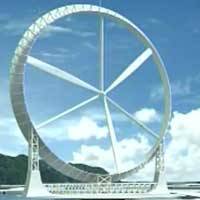Source: mnn.com
Published: August 29, 2011
A surprising aerodynamic innovation in wind turbine design called the ‘wind lens’ could triple the output of a typical wind turbine, making it less costly than nuclear power.

Snapshot from video
NOTE: Some major wind projects like the proposed TWE Carbon Valley project in Wyoming are already pricing in significantly lower than coal power — $80 per MWh for wind versus $90 per MWh for coal — and that is without government subsidies using today’s wind turbine technology. The International Clean Energy Analysis (ICEA) gateway estimates that the U.S. possesses 2.2 million km2 of high wind potential (Class 3-7 winds) — about 850,000 square miles of land that could yield high levels of wind energy. This makes the U.S. something of a Saudi Arabia for wind energy, ranked third in the world for total wind energy potential.
Let’s say we developed just 20 percent of those wind resources — 170,000 square miles (440,000 km2) or an area roughly 1/4 the size of Alaska — we could produce a whopping 8.7 billion megawatt hours of electricity each year (based on a theoretical conversion of six 1.5 MW turbines per km2 and an average output of 25 percent. (1.5 MW x 365 days x 24 hrs x 25% = 3,285 MWh’s).
The United States uses about 26.6 billion MWh’s, so at the above rate we could satisfy a full one-third of our total annual energy needs. (Of course, this assumes the concurrent deployment of a nationwide Smart Grid that could store and disburse the variable sources of wind power as needed using a variety of technologies — gas or coal peaking, utility scale storage via batteries or fly-wheels, etc).
Now what if a breakthrough came along that potentially tripled the energy output of those turbines? You see where I’m going. We could in theory supply the TOTAL annual energy needs of the U.S. simply by exploiting 20 percent of our available wind resources.
Well, such a breakthrough has been made, and it’s called the “wind lens.”
Imagine: no more dirty coal power, no more mining deaths, no more nuclear disasters, no more polluted aquifers as a result of fracking. Our entire society powered by the quiet “woosh” of a wind turbine. Kyushu University’s wind lens turbine is one example of the many innovations happening right now that could in the near future make this utopian vision a reality.
Yes, it’s a heck of a lot of wind turbines (about 2,640,000) but the U.S. with its endless miles of prairie and agricultural land is one of the few nations that could actually deploy such a network of wind turbines without disrupting the current productivity of the land (Russia and China also come to mind). It would also be a win-win for states in the highest wind area — the Midwest — which has been hard hit by the recession. And think of the millions upon millions of jobs that would be created building a 21st century energy distribution system free of the shackles of ever-diminishing fossil fuel supplies.

It’s also important to point out that growth in wind power capacity is perfectly symbiotic with projected growth in electric vehicles. EV battery packs can soak up wind power produced during the night, helping to equalize the curve of daytime energy demand. So the controversial investment currently being entertained by President Obama to pipe oil down from the Canadian Tar Sands would — in my utopian vision — be a moot point.
It is indeed a lofty vision, but the technology we need is now in our reach. And think of the benefits of having our power production fed by a resource that is both free and unlimited. One downside often cited by advocates of coal and gas power is that wind turbines require a lot more maintenance than a typical coal or gas power plant. But in a lagging economy this might just be wind power’s biggest upside — it will create lots and lots of permanent jobs, sparking a new cycle of economic growth in America.
Editor’s note: Want more info? Karl breaks down the math in his next post.
